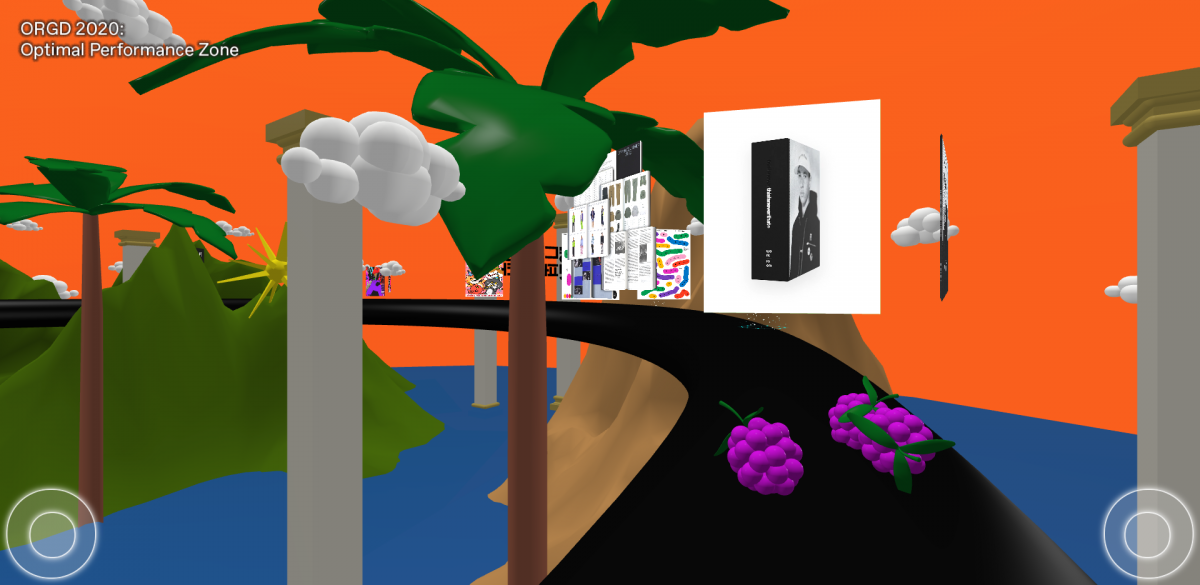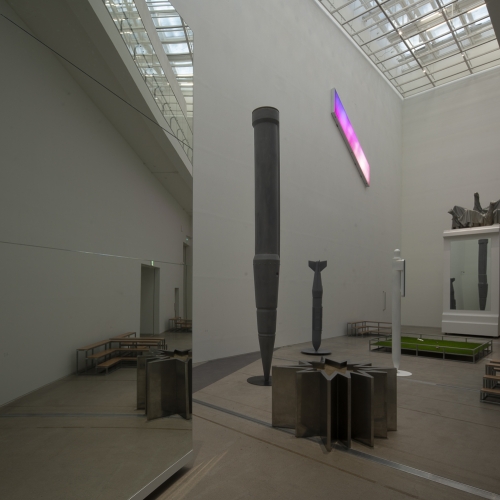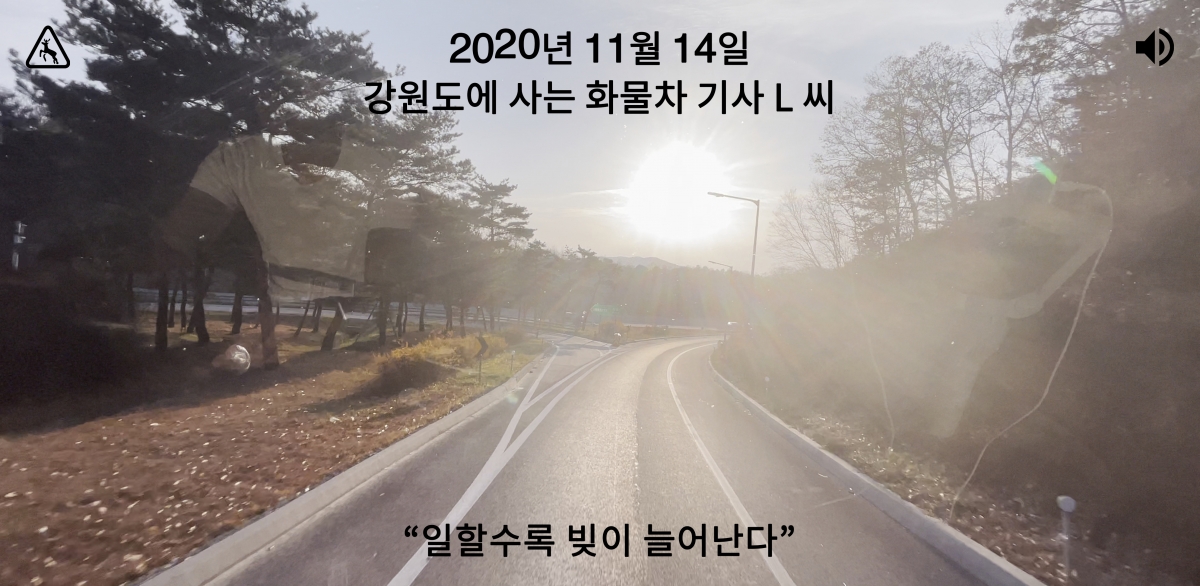At a click, you find yourself on the back of a large black snake (emblematic of wisdom), in the form of a circle with its tail in its mouth. The snake is a curved cylinder – you risk falling off if you do not maintain your balance. After repeatedly straying from the path and returning to zero, you finally reach a glittering destination point. Spread before your eyes are images and texts of the first artist’s work. However, at any hint of hesitation, you risk falling off again and returning to the beginning. Maintaining a sense of control, you advance. Once you eat the grapes (symbolising happiness) you can save your progress and move on to the next destination. The sky is filled with floating clouds (emblematic of truth) and the moon (insomnia or sadness) and the sun (glory and magnificence), and far off you can see the mountains (signifying ambition) and columns or palm-trees (mottos), and beneath you lies blue waters (an emblem of the tranquility felt from everyday actions) which stretches across to the horizon.
This 3D virtual space derives from the artist’s platform ORGD’s logo, which is simultaneously a compilation of the platforms completed works of 2020. To see the whole landscape, one must complete the trip. It is hard to pay attention to the works while trying to move forward without rolling off mid-route. The exhibition is a reminder of the nature of time, and how it becomes difficult to concentrate on what lies before our eyes, and through this, attempts show us what design can reveal. This approach, attempting to understand the significance of one’s work within the uncertainty of today, is a poignant imprint of the official title of the platform – Open Recent Graphic Design. Within the ledgers of time, the column of ‘recent’ elements are assigned to things that have already started to slip away from the crux of the present, yet which remain undetermined in terms of how they might connect with the past and the future. Rather than underlining the ways in which these malleable things have battled with history to occupy a place in the future, or suggesting that they are not entitled to such a hereditary title, the exhibitions of ORGD focus on exposing the ways in which our present time is like a loaf of readily-rising raisin bread. They aim to come in contact with those willing to discover this unchartered territory together.
The ideal audience for such an exhibition is more likely to be discreetly supportive or applicants to micro-funding platforms rather than the consumers of readymade products or the buyers at an industrial fair. If we are presently at the here and now, how can we move forward? The exhibition intends to revive a sense of common aspiration, responsibility and resolution for the time that lies ahead of our insecure place in the present. As such, the objective of the exhibition is to reconstruct our disorderly fragmentary times into a usable space, or at least to understand the topographies of such time to draw out the available expansive gestures in actions and pathways. Here, the focus on recent time is not a fixed single meaning. It could mean strategically occupying the present day, a point closest to the future, but it could also mean the rejection of such future-oriented thinking to delve deeper into the unclear present. This may be an attempt to intentionally sever our connections with the past, or an attempt to ruminate on the conditions of unwilling separation from the past. The present time is showcased as the floating state of all time-bound relationships, disseminated through a unique sense of insecurity. As an isolated event, the exhibition elevates this feeling of insecurity to a light-hearted sense of arousal. The exhibition at this point in time is not simply a representation of a given time, but is a primary production device that proposes a tangible form of a today differentiated from that of yesterday. Countless exhibitions competitively declare that now is their time, and attempt to redefine the present, or at least strive to stay pertinent in the visible horizon of the present. Aspirations towards an authoritative map of time became greater in the places where the framework of regular time no longer exists.
Yet, time cannot be completely spatialised. If the present is considered to be a platform on which anyone can participate and expand without limits, it blinks like a massive screen that refreshes at every moment, intermingling with the impressions of the other present moments that have passed on ahead. Nobody is guaranteed a bird’s-eye-view of the whole. The scope of that which exists, is recorded and that which is seen is limited, regardless of the watchtower in which we position ourselves as an approach. Meanwhile, the attempts to draw a map of the present times is a comprehensive conclusion of a compromised assortment of the pathways traveled by each maker of a map. Therefore, without the hope of a mighty common denominator or an immense sense of purpose strong enough to shoulder the burden of everything, the art of crafting a map of the present time can be more likened to the handicraft of weaving a basket. The long-term project of ORGD comprises selecting each of these trajectories, bending them and connecting elements which are disconnected, to conceive a stable and expandable netted form.
The 2019 ORGD exhibition summons a composite ‘individual’ who has journeyed across diverse sections of space and time by twisting together the experiences and knowledges of its many participants. While this hypothetical being – born in Gwacheon, South Korea in the 1980s, immigrated and spent their youth in a small city in Japan in the 2000s, studied design in the US, returned to Seoul in the 2010s to run their own design studio – may represent a particular generation, its face remains in a haze. The volatile present, while subject to passing trends yet resistant to becoming a uniform zeitgeist or style, is structured like a sponge, continuously sucking in and spitting out the resonant imprints of other generations and other areas. These present times keep on connecting to other present times, yet do not bolster a sense of belonging with the past or a sense of purpose in the future. This landscape, permeated with an ambiguous yet tenuous sense of disconnection, simultaneously reflects and idealises the realities of the makers of the exhibition. In terms of the diverse works on display in the platform’s 2019 exhibition, the curator wrote that ‘while it may come across as a lot of work to shoulder for a single person, the graphic designers of today are also people who simultaneously accomplish all of this as if it is not a big deal’. The fact that one person must possess diverse experiences, and even more plentiful portfolios, as if they were many people, to radiate one’s presence at all times and everywhere somehow seems like the order of the present time. Under this impossible guideline, which cannot be purely obeyed nor easily denied, countless presents repeatedly enlarge without structural reinforcement, tumbling down from self-inflicted exhaustion and are again constructed anew. Other than swiftly cutting across this time like a snake, or continuing with the circus act of narrowly crawling forward hanging on to the snake’s back, would it be possible to draw a form of time which differs in some way? What kind of spaces are required to do this? This is the question posed by the exhibition halls of today.

Exhibition view of 'ORGD 2020: Optimal Performance Zone' (2021) / Image coutesy of ORGD






